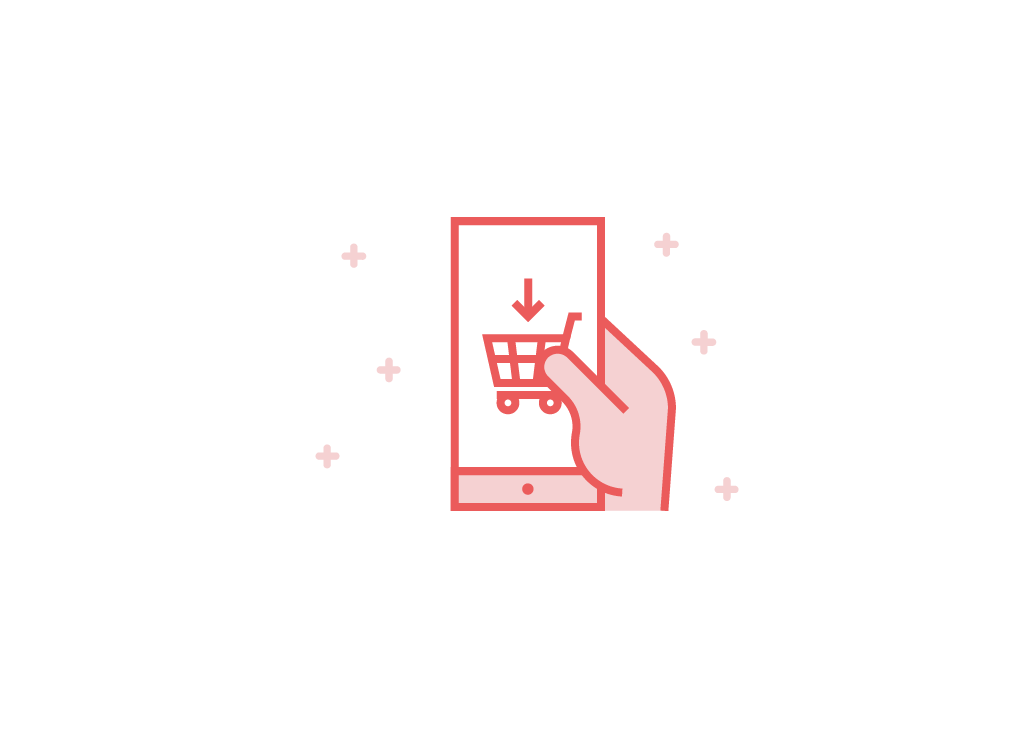One of the most common problems people in E-commerce constantly face is that their visitors do not convert to the degree that that is wished for. Because of this, we have collected our seven best tips on how to turn your visitors into customers.
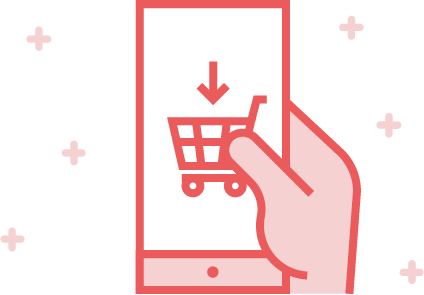
Optimizing your E-commerce conversion rate can feel like a long and complicated process that requires deep data insights, which, to some extent, is true. Fortunately, today there are several services that facilitate data collection by telling you how your visitors use your site, so you know where to focus your efforts. When you know where your bottlenecks are, you also need to know what to do about them. Often when it comes to sales, there are three main things to consider: satisfying needs, informing, and attracting.
Before we begin …
Google Analytics
To succeed with your conversion optimization, you must first know how your visitors use your site, which pages they visit, where they usually abandon their shopping cart, and where they experience the most friction. To collect such data, you can (read: you should) use Google Analytics. Google Analytics is a data analytics service that helps you collect, process, and report website and app data in a simple and straightforward way. The service ensures that your website correctly reports conversions and other significant information so that you can see how your actions affect the website and the customers’ behavior. Getting started with Google Analytics is easy, and we recommend Google’s own guide for this.
A/B-testing
When deciding what to invest in, you need to test your new solutions through A / B testing, to find out which solution works best and converts the most amount of visitors. There are a variety of services for these types of tests, such as Google Optimize which works seamlessly with Google Analytics.
Let’s say you have an e-commerce with 1000 unique visitors every day. You are both the cheapest and fastest option on the market, but still, there is something that makes only 1% of your visitors make a purchase. With the help of Google Analytics, you have seen that many of your visitors put products in their shopping cart but then abandon it when they arrive at the checkout. You decide to test if it is the colour of your pay button that may be too similar to the background colour and therefore is missed by many visitors. You want to test if it works better with a different button colour and therefore set up your website so that half of your visitors get the old button and the other half get a new green button. Apart from the colour of the button, everything else is unmodified.
If you now notice that your conversions increase over time, you know that it is precisely the color that was the culprit, the green button is much clearer and as many as 4% of your visitors now complete their purchases. If you do not notice any difference, it is not the button that was behind the low conversion rate, and you must move back to square one, to find out what on the page is causing your visitors to abandon their shopping carts.
This is a very simple example of an A / B test, as they often go into much more detail, but the principle is the same. Once you have understood the importance of thorough data collection and well-performed tests, you are ready to take advantage of our seven concrete tips. Complete with examples from some of our previous projects, that will help you decide what you can do to turn your visitors into paying customers.
- User Friendliness
- Content
- Customer Service
- Offers, Free Shipping, and Returns
- Offer several different payment options
- Social Proof
- Find your USP
1. User Friendliness
Judging and evaluating the user-friendliness of your own E-commerce can be difficult, if not almost impossible, and you need to test it on many different users before you find the parts that create friction on the path to purchase. Since you probably visit your E-commerce several times a day, you have learned exactly how it works, where to click and what shortcuts there are, which most likely is not the case for a new visitor. Poor usability can discourage the most affluent visitors, and you must therefore design your E-commerce in a way that creates a natural flow in the path to purchase, without a lot of distractions and unnecessary steps. The journey from the product side to the checkout must be as simple and straightforward as possible.
Mobile first
Developing your E-commerce for “mobile first” should be a matter of course at a time when mobile devices are becoming more and more commercially friendly. If you look at a pioneering country such as China, you can see that as many as 79% shopped from their mobile phones, a figure that western countries are likely to catch up to in the near future. The example presented below shows Equestrian Stockholm, whose large following on social media demands at least as good shopping experience on mobile as on a desktop.
- Test your E-commerce on real people to discover eventual friction.
- Create a natural flow in the path to purchase.
- Think “mobile first”; visitors from mobile devices will only increase.
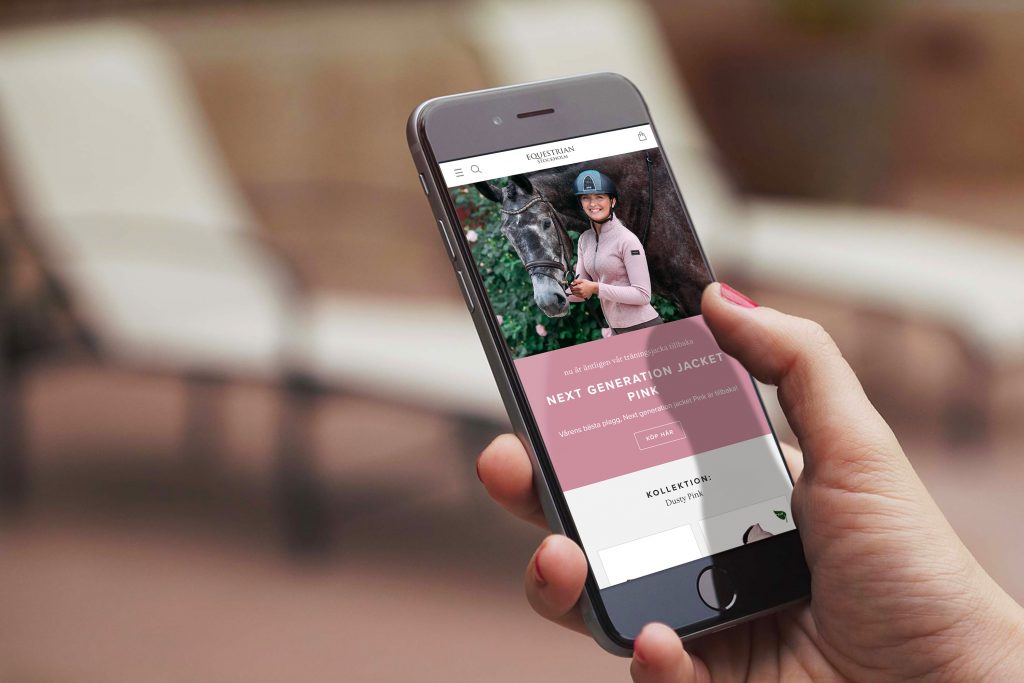
2. Content
Pictures
The single biggest obstacle a customer faces when shopping online is that they can not feel out and try the product. To minimize this obstacle, you as an E-retailer must do everything you can to give the visitor as good of an idea of the product as possible. It is often said that a picture says more than a thousand words, and it has never been more true when it comes to E-commerce. In order for your visitors not to choose a competitor who presents their products better than you do, your product images must be really, really good. Hiring a photographer can often be a well-worthwhile investment that quickly pays off. A skilled photographer can take high-quality photos that represent your brand and capture the product’s feel in the best way. When we developed Absolut Arts’ E-commerce, we realized early on that the entire shopping experience would revolve around large product images, to give the works of art the attention they deserved.

All customers want to see different types of images. Some customers prefer to see the product completely exposed without distractions, while others want to see an inspiring picture where the product is placed in an exciting environment. Try to satisfy both types so that no one loses interest in your site and seeks out another store.
- Hire a product photographer.
- Present the product from all sides and angles.
- Use high-resolution images that allow the user to zoom in on details.
- Showcase the product in different environments.
Product descriptions
In order for your visitors to get a good idea of the product, good images are not enough, your product descriptions must also convey the product’s characteristics in a way that makes your visitors want to read them. In order to write good product descriptions, you must have a clear picture of both your customers’ needs and the product’s value proposition, i.e. how the product meets the customer’s needs. Try to predict your visitors’ questions about the product and answer them in the text. Depending on what it is you are selling, you can often benefit from writing product descriptions that stand out. Simply lining up the product’s properties in a bulleted list is not particularly selling. Try using storytelling and create a story that tells why the product will meet the customer’s needs and place the bullet point list below. As someone once said, “Facts tell, but stories sell”. In the example below, you will see Love Warriors, who have managed to create a story around a product as simple as a cutting board.
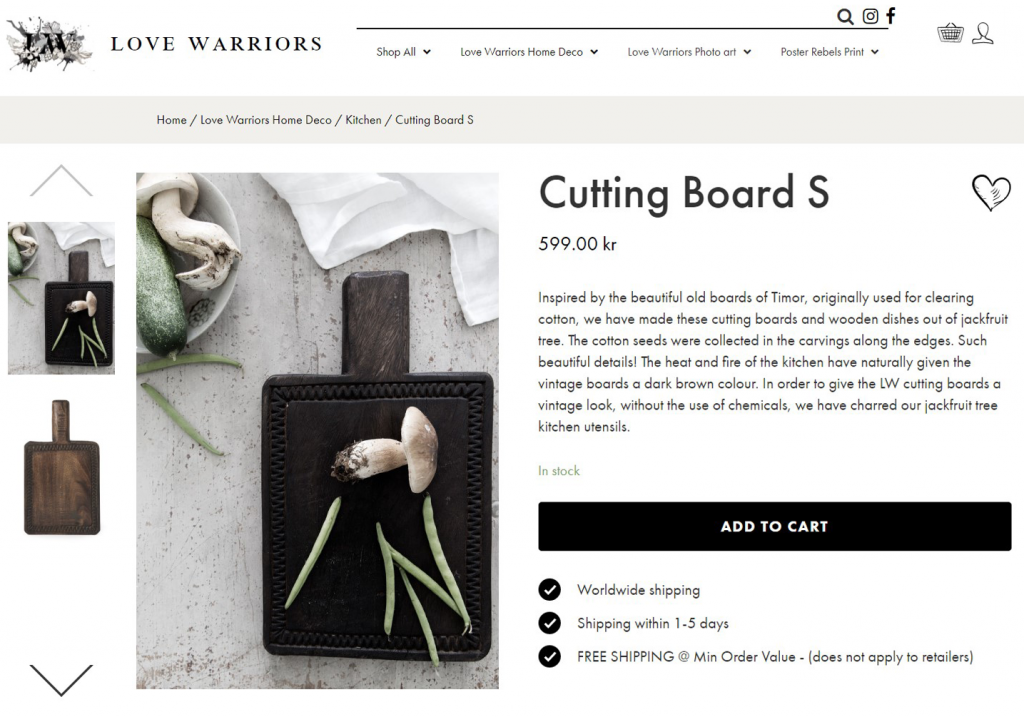
- If the product allows for it, use simple language that makes the text easy to read.
- Identify the customer’s needs and respond with the product’s value proposition
- Dare to add some flare!
- Ask someone to proofread.
- Check for spelling errors.
- Ask someone to proofread again.
3. Customer service
Despite your inspiring images and exciting product descriptions, there will always be customers who want more information about your products. Like providing multiple payment options, you should also offer several different ways for your customers to contact you, as some prefer to chat or email over the phone and vice versa. Today’s direct communication has meant that we expect good service and answers in a very short amount of time, people, in general, do not have time to wait around for hours or even days to get answers for when a certain product will be back in stock. Therefore, try to answer your customers’ questions as soon as possible. But, do not forget that it is more important that you give each customer a satisfactory answer than that you graze as many customers as possible in the shortest amount of time possible.
Today, there are several different services that can help you with customer relationship management, such as Intercom and Operations. Ales & Brews chose Drift as a service and can now give all its customers a personal reception and treatment, regardless of who is responding.
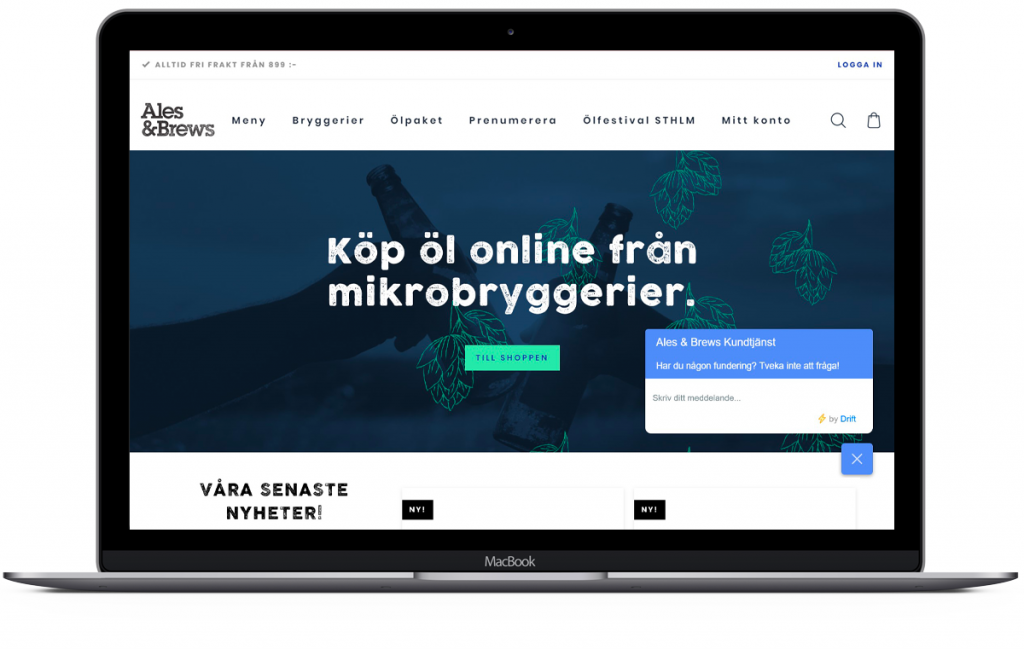
- Offer multiple contact options.
- Respond quickly.
- Quality over quantity.
- Compile and answer the most common questions in a FAQ.
- Create a relationship with your customers.
4. Offers, free shipping, and returns
When you start calculating how much you have to sell in order for your new campaign to be profitable, you may first be discouraged. A 30% discount on the entire range may mean that you have to sell more than twice as much as usual to not end up in the red. But, remember that such a campaign is an investment for the future and will increase your customer base.
Once you have built a customer base, you need to nurture it. Customer relationship management, CRM, is a topic in itself and is about caring for the customers you already have, as this is often cheaper than finding new customers. An example might be sending out personalized offers to all new customers you received thanks to your campaign. However, be careful about what you send out to whom, how happy would you have been if you had received an email about a discount on a product you just bought at full price?
Free shipping and returns
In the large country in the west, free shipping and returns have long been standard in E-commerce. Even if you know you have too small margins to consider free shipping, remember that it is often a psychological game. Being able to boast “always free shipping and returns” usually weighs more than a price increase of a few percent on the entire range. If your customers can order delivery to their homes, try and offer the return of the products free of charge, because what do they then really have to lose? Of course, your shipping costs will increase, but so will your conversion rate.
- Invest in a campaign to increase your customer base.
- Attract existing customers with personalized offers.
- Be careful who you send what to.
- Offer free shipping and returns.
5. Offer several different payment options
Shopping from a new store for the first time can be problematic, especially if you do not offer your customers their preferred payment method. In the Swedish E-commerce survey 2018, 45% of those surveyed answered that they had canceled an online purchase in the past three months and 32% of them canceled because the store did not offer the preferred payment method. To survive as an E-retailer, you must, therefore provide several different payment methods; otherwise, some of your visitors might turn to your competitors to complete their purchase.

Make it easy to pay
However, it is not always enough to just offer the right payment options. The checkout process must also be quick and easy. In the same survey as previously discussed, 54% answered that they wanted to avoid entering card details for each purchase and fortunately, it has become easier than ever for you as an E-retailer to recognize and help your customers. Both Klarna, DIBS, and Billmate let your customers save their delivery and card details so that they are auto-filled when they arrive at the checkout, which means that your customers can pay with one click.
- Offer several different payment options.
- Make it as smooth and seamless as possible to pay.
- Use a payment service that recognizes and remembers your customers.
- Social evidence
Customer reviews
Using social proof is an effective marketing technique that involves you justifying a product by showcasing other customers who have purchased the product. Your visitors will most likely trust other customers more than they trust you and sometimes a good customer review is all that is needed to convert an insecure customer. Highlight your customers’ reviews on the product pages and reward those who write really good ones with something in return, e.g. a discount code or free samples.
Trust badges

Another way you can win the trust of your customers is to use so-called “trust badges”. Trust badges are small images you use on your website to show your customers that you are a salesperson to trust. One example is the Guaranteed Safe Checkout badge. This badge indicates that your checkout process can be trusted: the information is encrypted and your customer’s credit card information is safe and secure. In turn, ensuring badges like this will likely help increase your conversion rate.
- Highlight product reviews are written by your customers.
- Show off trust badges.
7. Find your USP
Prideful Showcasing
What makes your E-commerce unique? What is it that makes your visitors choose to shop from you instead of the competitor? Finding your USP, your unique selling point, can be difficult in a saturated market, but it is still a must when you want to differentiate yourself from similar players in the market. To find what exactly makes your E-commerce unique, you must start with a thorough market analysis to get a clear picture of what is offered in the industry today. Then think about what you can provide that no one else offers. Are you the cheapest, fastest, biggest, or trendiest? Show this off with pride!
Sometimes we meet E-retailers who want to “be the best at everything” or “exist for everyone”. It is a nice vision, but the risk is that if you try to stand out by being known for being the best at everything, you fall short and often do not become known for anything. Try to pick one or a few aspects and then work really hard to get the best at it.
- Be proud of your USP.
- Do not try to be the best at everything. Many have tried, few have succeeded.
Conclusion
Conversion rate optimization is about testing, evaluating, and implementing. Your customer base is not like any other, and therefore there is no universal method that works for everyone, you have to discover for yourself what it is that makes your visitors click on your buy button. The most important thing of all is that you let it take its time. Do thorough analyses using your collected data and never solely do something because it “feels right”. Hastily made decisions based on emotion will most likely only lead to confusion for your visitors, and a confused visitor rarely becomes converted customers.
